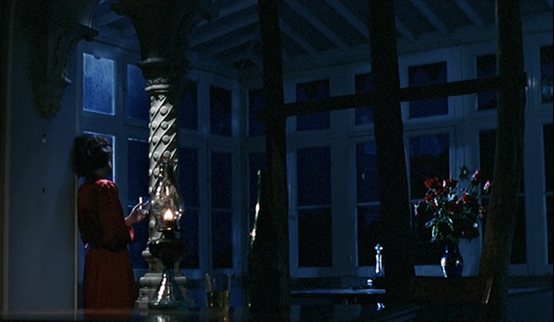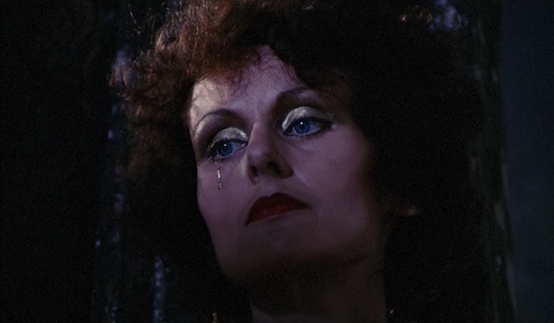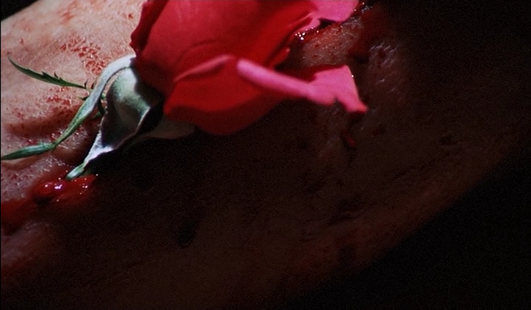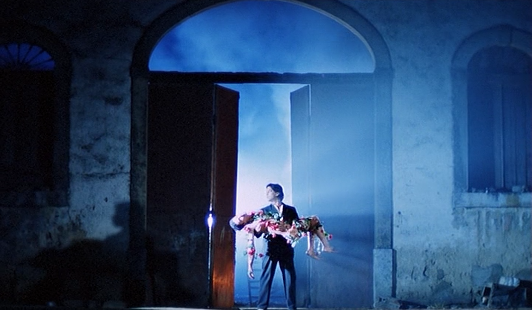The Barbarism of Classicism in Der Rosenkönig (1986)
25/08/2024
- Y. Z.
25/08/2024
- Y. Z.
Having attended the screening of Werner Schroeter’s seminal work The Rose King/Der Rosenkönig (1986) a few days ago, I stumbled upon many criticisms on Schroeter’s films, particularly this one, where the critics (casual cinemagoers), perhaps unfamiliar with his mode of filmmaking, termed his film “meaningless”, “repetitive”, “obvious in its symbolism to an excruciating point”, something along these lines. None of these are direct quotes, but the sentiment is clear: it is too simple, too puzzling, there is no clear narrative, the themes are too obvious. First of all, to fall into this line of thought is to automatically prohibit oneself from any serious engagement with any work of art. To place oneself above the intentions of the filmmaker is one of the biggest mistakes one can make when approaching film, because the superiority of the spectator does not exist in the relationship between filmmaker and spectator. I recently read an excerpt of an interview with Marguerite Duras by Jean Narboni and Jacques Rivette, where Duras proclaimed the complete destruction of the self into a state of tabula rasa as the only pathway towards the existence of communism in our present society, where Freud, Marx and Lenin are “historical monuments” instead of thinkers. Indeed, Duras acknowledged that even though Freud is “easy” to read, the reading of Freud is inevitably “a prey of worldwide interpretation”. So, how does one stray away from being prey, and instead find new, personal, revolutionary meaning within this semiotic interpretation that is so rampant in film and art culture? To take it anew, to be in a state of ignorance, but aware of it in cultural form at the same time, to experience firsthand the images and sounds that communicate with each other to produce a new and complete set of meaning(s).
Schroeter’s cinema falls into that category which has alternatively been described as both “classicist” and “anti-classicist”. Thus, through these lenses, it can be taken as a series of contradictions within a major contradiction that is the work itself – its simultaneous existence as a whole and complete work and its engagement in synthesis through addition. The structure is this: Schroeter presents a beginning-image, elaborates on this beginning-image with other images which also act as beginning images of their own, shows them again to end their singularity, then bookends the sequence with the first beginning-image, now acting as an ending-image. Every single sequence throughout the film is built upon the previous one. There is no singular image that does not have a counterpoint, there is no image that exists singularly without the support and interplay of others. As thus, they become almost archetypal: there is an essence that can be extracted from each of them outside the domain of familiar reality. This is also why the film feels so alienating, so “oneiric”, to use a term popularised by those who are more affected by the experience itself rather than by the components that make up the experience: the magnification into the symbolic essence of the image distorts space and constructs a reality of its own, outside the rules that govern the world the spectator lives in. According to Arnold Hauser, the anti-classicist work is one that rejects the fiction of traditional filmmaking and aesthetic dogmas, that it is “impossible to add to or subtract from the individual components of a work of art without endangering the artistic value and effect of the whole” (Hauser, 1965, p. 24), a line of thought based on the strictest and purest principles that classicism adheres to. However, Hauser’s outline of classicism involves the implication of singularity in its existence, but what is classicism if not for the contrast between tradition and barbarism? In this way, Schroeter’s cinema is, in some way, related to that of filmmakers like Raúl Ruiz, Hans-Jürgen Syberberg and even Sergei Parajanov at its extremity, in the sense that the very act of composition is highlighted within the composition – objects exist because they are placed and arranged, not because they simply exist. The attention to form is present, but the attention to the malleability of form is also present – something that is lacking in the most rigidly and exclusively classicist works. The desire to preserve the “chaotic and inexhaustible riches which classicism, by its crystalline forms, tries to conjure out of existence” (Hauser, p. 24), then, suffices as the reasoning of the existence of Der Rosenkönig.

Another facet that contradicts itself in Der Rosenkönig is its rejection of theatrical and novelistic structure whilst simultaneously invoking the plurality of artistic influence through music and language. Music is almost constantly playing, and when it is not, sounds from another space outside of the frame can be heard, whether that be singing or unintelligible shouting. There are 7 languages being spoken in the film, besides German, there is also Portuguese, Italian, English, Arabic, French, and Spanish. As the use of these languages are confined to very specific circumstances and sequences within the construction of the film, in a sense, they also encapsulate this desire to synthesize through addition, to dispel the singularity of already established filmic elements in favour of combining them with new ones. The cast & crew being multilingual – the German director shooting in Portugal with a Portuguese producer and crew (with a young Rita Azevedo Gomes working as set decorator), the use of Algerian-French and Italian actors, respectively – seeks to define that which is outside the constructed space of the film – the Arabic history of Portugal reflected in its language and architecture, the unavoidable connection between Germany and Italy, possible references to Buñuel in the chanting and singing in Spanish and in its proximity to Portugal. Curiously, only English and French seems to be directly imbued with the principles of narration in the literary quotations used. Ultimately, the justification of their respective inclusions boils down to the precise moments in which they appear and the moments before and after, created by the most intricate but distant dialectic between image and sound. Emotions are created through the many diverse cultural and artistic implications that each insert of sound and language brings, although the spectator is not expected to understand them, and this alienation to the source of emotion is part of what makes the images seem archetypal: the traces of feeling suggested by the cutting, clearly manipulated to be felt, contain feelings that are absolute and primal in our incomprehension of them.

The feelings are absolute because the symbolism is absolute: the rose – blood, passion, the knife – violence, the black paint – to bring darkness into the world in the sense of self-destruction, the desert - despair. I am against psychology-oriented cinema, one that procures a meaning for everything, for each act, one that restricts their freedom in the thought of the viewer, because, tying back to Duras’ argument, our conception of psychology is not unique, it is the result of a worldwide interpretation that sets a repressive standard. Even though Schroeter has clearly constructed a psychological framework for the film with the “obvious” Oedipus complex between mother and son, as well as the symbolic depiction of the at once caring but violent attraction of the son to the man, the psychology acts as a means to an end for the symbolism, while the symbolism then doubles back to act as a means for a new end – the psychology. Thus, we are presented with the structure of the film again - a clear pathway which seems to regress to an old identity, but instead ends up synthesising new perceptions at the end. And, because the psychology is reached through symbolism, it gets filtered into its essential elements, and the spectator is now able to have a personal interpretation that is outside the space and ideology that the status quo normally and universally occupies. This is why the climactic sequence is so affecting: the spectator is led to believe in the progression of the images in their absolute, psychological form, and is led to believe in the inherent need for psychology to be reached through symbolism. Subsequently, the violence of this ultimate act is highlighted through this lens, and the irreversibility of the spectator’s acceptance of its need is exposed. This state is, after all, the sign of the accomplishment of this intersection between classicism and anti-classicism, a labyrinth where we lose ourselves in and do not seek to escape from (Hauser, p. 25).



Citation(s):
Hauser, A. (1965) Mannerism: The Crisis of the Renaissance and the Origin of Modern Art. London: Routledge & Kegan Paul Limited